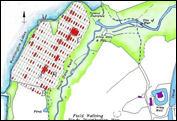Chapters
|
Project: Roman Mining
| Research
It is well documented that coal has been mined in the Wigan area
since the 14th Century, but could it be possible that the Romans were doing it
first?
In 1982 excavations in the centre of Wigan revealed extensive evidence of
Roman occupation dating to the 1st and 2nd centuries AD.
Amongst the finds, the archaeologists found scorched clay, iron slag, charcoal and
significant quantities of coal (1). From these remains it was obvious that the Romans
were carrying out some kind of metalworking operation. The use of coal is
hardly surprising considering the fact that high-quality coal seams outcrop all over the
Wigan area and could well be the reason that the Romans were attracted here in the first
place.
1982-4 Wiend Excavations |
In Britain as a whole the Romans used
coal extensively, as a recent article in The Antiquaries Journal, testifies. It was complied by Martin. J. Dearne and Keith
Branigan and catalogues over 200 sites in Britain (2), including the Wigan example, where coal
has been found in an archaeological context. Despite extensive research, however, the
authors of this report were unable to identify a single site where evidence for coal
extraction could be shown.
So where were the Romans getting the coal from?
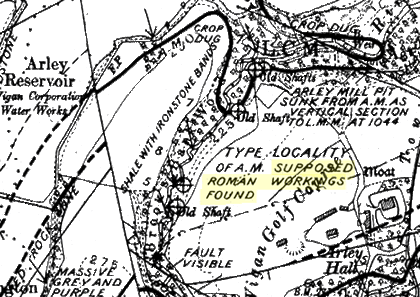
On this 1930’s map, the note‘SUPPOSED ROMAN WORKING FOUND’ is marked in the area which is now part of the golf course of the Wigan Golf Club at
Arley. The map was commissioned by the Geological Survey of England and Wales
(Lancashire Sheet 85SE) and shows the various coal measures and where they outcrop,
including the famous Arley seam, whose quality is renown throughout the South Lancashire
area. |
Ancient Workings
| Presumably the map-makers got the Roman reference from evidence given
by the Victorian geologist Edward Hull who mentions ‘ancient workings’ at Arley
in his memoirs published in 1860 (3). He specifically identifies these workings as Romans in
his book entitled “The Coalfields of Great Britain", published in
1861 (4), in which he describes finding "a series of polygonal chambers, with vertical walls
opening into each other by short passages “. He
goes on to say “The chambers were regular in both size and form over an area of at
least 100 yards and were altogether different from anything within the experience of the
miners of the district”. Hull was
convinced of their Roman antiquity, remarking on “the symmetrical arrangement and
regularity of workings … reminding one of their tessellated pavements or ground plans
of their baths and villas”. |  Arley Golf Course (Click on thumbnail for larger image.) |
 River Douglas entering the tunnel (Click on thumbnail for larger picture.) |
Edward Hull’s ‘workings’, however, where not under the golf course, but in the
adjacent field which lies between the Arley Brook and the Worthington Lakes. The River
Douglas flows directly under this field, in a tunnel in which dates to the 1850’s. At
that time the reservoirs were being constructed to supply drinking water for the Wigan
area. The River Douglas, however, happened to be the main drainage for all the mine water
being pumped out of the many shafts and ‘soughs’ along the Douglas Valley, thus
it had to be diverted to avoid the resulting pollution. It was during the construction of the tunnel that Hull, acting as government
inspector, identified the ancient coal workings (5).There
was also a report at the time of hoard of Roman coins being found in one of the galleries,
however Hull does not mention these and so far no other corroborating evidence has
emerged. |
|
|
Field Work In 1998 the Wigan Archaeology Society carried out extensive field walking in this area but,
despite collecting over 1200 shards of pottery, a Roman connection was not establish
(see
News Letter 14). |
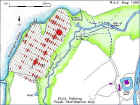
Results of field walking
(Click thumbnail for larger image.) |
|
Excavations
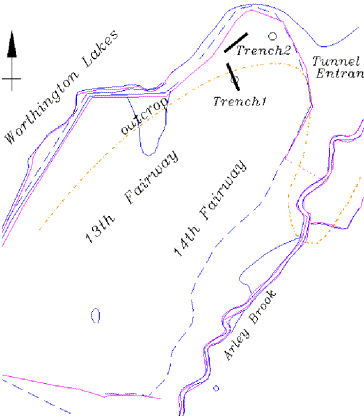
The
following year, the nine-hole course of Wigan Golf Club at Arley was extended to a full eighteen holes. Before construction, an archaeological assessment
was carried out in the area around the 13th and 14th fairway
(see
Newsletter 38), which happen to be in the field beneath which the 19th century
tunnel runs. The assessment, carried out by Lindsey Archaeological Services of
Lincoln (6),
involved stripping the topsoil and excavating two 25 metre long trenches. Again no specifically Roman activity was detected,
but a considerable amount of ground disturbances was evident including at least two
unrecorded mineshafts. Without completely digging these out it would be
impossible to date these and, as landscaping of the greens is now complete, the chances of
further investigation in this immediate area is now impossible.

Trench 1
(Click on thumbnail for larger picture.) |

Unrecorded Mineshaft
(Click on thumbnail for larger picture.)
|
|
| Roman Evidence
We all thought that was that but a
year later a remarkable new discovered came to light, in an area not far from the
tunnel field we have been investigating. A
member of the Wigan Archaeological Society, who lives near to the Worthington Lakes, found
a quern stone half-buried in the ground, while field-walking near his home alongside the
Doulgas valley. The 44cm diameter stone,
which has a 7.5cm hole in the middle, would have been used for grinding corn and is
thought to date from the 1st or 2nd century AD. It has been confirmed as Roman by Lancaster
University, who have described it as a military grindstone and would have belonged to an
eight-man unit (10th part of a century). The find has been properly recorded
and entered into the Sites and Monuments Record held by the Lancashire Arch Services based
at Preston.
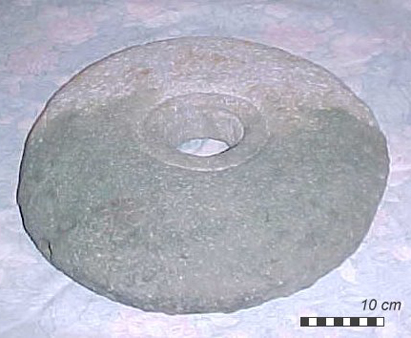
Foot and mouth restrictions that year prevented further detailed
study of the site, but before these came into force, a quick check of the area immediately
around the spot, failed to find any archaeological context. There should also be a lower
stone upon which this stone acted. As soon as the recent emergency restrictions have been
removed, the society will be able to carry out a complete survey of the find area and
hopefully establish the full extent of the Roman activity.
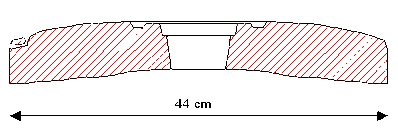
Finding the Roman quern stone has caused quite a stir, as it may well confirm the report given by
Edward Hull as being genuinely Roman. This would perhaps establish a unique site in the
British Isles as well as being a significant first for our society. |
Bill Aldridge
Wigan Archaeological Society
Bibliography
- Greater Manchester Archaeological Unit Journal - 1984
- The Use of Coal in Roman Britain by Martin. J. Dearne and Keith Branigan - The Antiquaries Journal - 1996
- Memoirs by Edward Hull - 1860
- The Coalfields of Great Britain by Edward Hull - 1861
- Wigan Coal & Iron by Donald Anderson & A A France - 1994
- Arley excavation report No. 364 by Lindsey Archaeological Services - 1999
|
|
